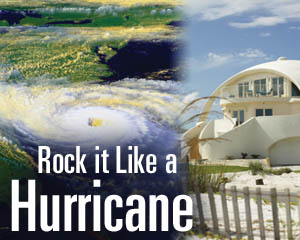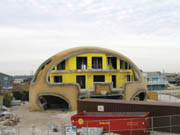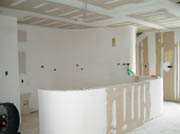
Remember the Righteous Brothers' ballad "Ebb Tide"? How Bobby Hatfield and Bill Medley persuaded radio listeners to camp along the beach on warm summer nights, listening to the crash of the surf? Whether it was from the duet of the singers' harmony or Phil Spector's orchestration, it was the aural advertisement that told listeners the beach was the place to experience absolute serenity, peace and habitation. This isn't necessarily misleading but what the lyrical content didn't mention was that tides could come thrashing violently, water logging buildings and beyond. Throw a hurricane in the mix and one is safer surfing swamps in the Everglades.
The resort home in Pensacola, Fla., purchased by Mark and Valerie Sigler in 1993, offered all the amenities that the song mentions. It also offered two hurricanes by 1995. The shrieks and noise of heavy winds, rain and water replaced the gentle breeze of the ocean, thanks to Hurricane Erin and Hurricane Opal. The Sigler home was one of 20 left standing from an original count of 220 small blockhouses-though still suffered major damage.

Moldy pieces
The Federal Emergency Management Agency had notified the Siglers that they-from a pool of 11,000 residents-were eligible to apply for a Flood Mitigation Assistance Program because of the damage to the home. This sweeping offer to the community was for funds of $2.1 million."Which was about a roll of duct tape and some plastic for each person," says Mark Sigler.
Tired of all the mold-among other problems-that had developed in their ductwork, fiberglass insulation and wallboard, the Siglers had thought about constructing an entirely different architectural unit; one that could withstand another hurricane and any ambitious waves that would crawl toward their house. So, they researched different alternatives and discovered dome homes. Architects that had served in the military had influenced a lot of the concepts of these styles of homes. San Francisco architect Jonathan Zimmerman, based in Marin County, Calif., had served in the Navy and had knowledge of aerodynamics and hydrodynamics.
"These steel-reinforced concrete shells take 300-mile-per-hour winds, due to the fact that a dome is an aerodynamic shape and this shape is an entirely steel-reinforced concrete structure from ‘head to toe,'" says Zimmerman. "The only way to economically form such a shape is by air forming. You can't inflate a shape with corners and flat planes."
Zimmerman says that the point of the design for this project was to comply with local code requirements, which do not permit residential structures to have any floors built on the ground level (except garage units). The Dome of a Home's first floor is 11 feet above ground, which conforms to local code and FEMA requirements. But all designs, products, building techniques, etc., had to be carefully considered because of the proximity to the ocean and the exposure to water and moisture.
Among many of the products used to address the marine elements, the builders used Georgia-Pacific's line of moisture-resistant DensArmor Interior Plus Guard, a stock of gypsum board that is made with coated glass mat facings that resist mold growth. For exterior sheathing, the builders also chose G-P's DensGlass Gold. The previous insulation used on the Sigler's former blockhouse had fiberglass batts. When the hurricanes had brought smashing waves against the home, the insulation was soaked and never completely dried. To completely ensure the insulation would not risk being waterlogged, the builders used spray urethane foam.
"When we tore our old house down, the pink fiberglass insulation was green, with mold, from the different storms that had hit and it could never dry out," says Sigler. "So, it created a real issue when you can't dry out your insulation because it gets wet like that. Anytime you're in a flood zone that's something that happens. A house gets flooded, the insulation gets wet, and it gets very difficult to dry that out without tearing down walls and stripping all the insulation out."
The exterior walls got 5 inches of urethane foam sprayed in between the sheathing and the drywall; all the interior walls received at least 2 inches of insulation. As Sigler says, this type of insulation was reported by FEMA to have five times the strength in the walls and roof as it was before.

Shapes and curves
One system that Sigler says helped the aesthetic value of the home was the Flex-C-Track, from Flex-Ability Concepts. Originally, the layout of the home called for a few curved walls. After the building crew began using it, everyone decided they wanted more curves throughout the home."Normally, when you do a curved wall you take a bottom plate and cut it every 1/2 inch so that you can bend or flex it," he says. "But this ... will bend and flex in any shape you want so you don't have to make all these tedious cuts, and try to bend and shape it. That allowed us to basically make every wall in the house that we wanted to have a radius or a curve, because initially the house wasn't going to have as many radii as it ended up having. So, we were able to make free-form showers, just about any shape we wanted with it. We changed stairs, exterior walls, all kinds of things we weren't initially going to use."
From utilizing new technology and architectural designs, everyone involved in the project considers the dome home to be the next building trend. Because it conforms to FEMA and selected regional and state codes, coastal residences now have an alternative to homes that are often subjected to extreme weather conditions.
"It was gratifying to hear at the Island Authority hearing, a local architect on the review board staunchly defend this design, saying that this is the kind of construction which should become the new standard for buildings in hurricane areas," says Zimmerman.
Currently, the Sigler's divide their time between Montana in the summer and the Dome of a Home in the winter, which they rent out to tourists during the warmer seasons. For more information on dome homes, visit www.zdomes.com, www.scdomes.com, or www.domeofahome.com.


Report Abusive Comment